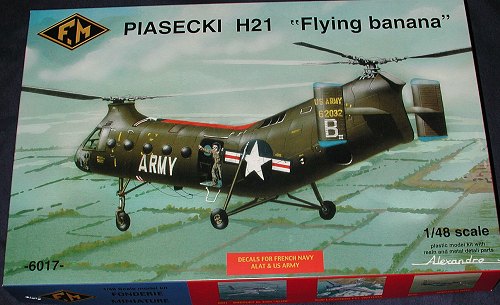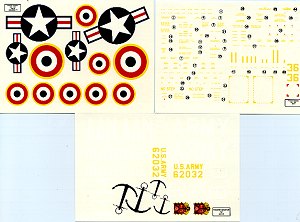
|
KIT: |
Fonderie Miniature 1/48 Piasecki H-21 |
|
KIT # |
6017 |
|
PRICE: |
$69.95 (59.96 at Squadron) |
|
DECALS: |
Three options |
|
REVIEWER: |
Scott Van Aken |
|
NOTES: |
Multi-media kit with metal, resin, etched brass, and vacuform parts. |

|
HISTORY |
Your standard Bell H-13 as you see on 'MASH' and most helos today use the smaller auxiliary rotor. Others, like Piasecki used a second main rotor, though it meant that the aircraft had to have a horizontal stabilizer, fin and rudder in order to allow the helo to turn. Other methods of the second main rotor are the intermeshing type as used on the H-43 (and on early German helos), the use of one above the other as on the Kamov Ka-25 'Hormone', or having the two main rotors separated side to side as on the German FA-223.
The H-21 was powered by a standard radial engine driving a gearbox that had output shafts running to other gearboxes that turned the rotors. Lots of power was spent in those gear boxes so early helos didn't have a lot of oomph and their carrying capabilities were not what they are in today's helicopters. The H-21 was used by the US Army and Air Force with many seeing action in Vietnam during the early days of the war. They were also exported and the French used them with some success during their war in Algeria during the late 1950s.
Unlike some later helicopters, the H-21 was not retro-fitted with turboshaft engines and to my knowledge, there are few, if any, still flying.
|
THE KIT |
 This kit comes in a very large box and it should as the H-21 was a
transport helo, designed to carry troops and cargo. Opening the box one
is confronted by three decal sheets, two sets of vacuformed canopies, an
etched brass fret, a small bag of resin bits, and several bags of metal
parts. There are also two sprues of clear side windows and a large bag
full of standard injected plastic.
This kit comes in a very large box and it should as the H-21 was a
transport helo, designed to carry troops and cargo. Opening the box one
is confronted by three decal sheets, two sets of vacuformed canopies, an
etched brass fret, a small bag of resin bits, and several bags of metal
parts. There are also two sprues of clear side windows and a large bag
full of standard injected plastic.
Inspecting the plastic parts, I noted that these are fairly well formed. Gone is the pock-marked surface of some of the older kits and while not glass smooth, is a huge improvement. There are no ejector towers typical of short run kits. I found a few sink areas, but these are on thick parts and easily filled. What I did find was flash, but even then, it wasn't much and is typical of what one expects of a short run kit. Even the detailing is well done and much crisper than on previous ventures though still a bit softer than on a high pressure kit like Hasegawa or Revell.
The two vacuform canopies are well molded and fairly clear. They are a tad thick, but I like thick vac transparencies as they are easier to glue. The clear side windows are fairly well done and though a bit distorted should do nicely. FM has gotten some nice resin for this kit and it has done the wheels, instrument console and aft gearbox in this material. Etched metal is used for the seat frames, some screens, instrument panel, seat belts and a few other bits. FM has never had problems with their etched metal as it is well done. I don't see a set of acetate instrument dials to go behind the panel and I think that FM should look into providing that. Metal is used for a TON of stuff on the kit including the cockpit seats, landing gear supports, rotor-head detail, antennas and other little bits and pieces. These are well formed and though all have seams that need sanded down, I didn't see any gross mold mismatch that can turn a promising model into a nightmare. One of my rotor-heads was broken during shipment (a problem with FM kits as the various bags of stuff are just left floating around in the box where they crash into each other during shipping), but I should be able to repair it with a metal pin.
Instructions are a bit different from what one usually expects. FM
provides no historical information and none of the usual construction
pictures that one normally gets with a kit. This one has a written
construction sequence with various diagrams to show the placement and
alignment of some of the more difficult parts. This is done in several
parts with each major part being provided with whatever color information
is required as the builder gets to those pieces. The diagrams are very
well done and leave no problems figuring out what goes where. All are
listed with had-written part nomenclature with some of the parts named in
English, but not most of them. It seems like an interesting way of doing
things and a real improvement over previous instructions. I'll have to
say that the 'jury is out' on this one until I get finished building the
 kit.
Markings are for three aircraft. One French Navy in overall gloss sea
blue in Algeria in 1956, one French Army in overall Olive Drab, also from
Algeria in 1958. The third is a US Army aircraft in overall OD, but it
would seem to me that perhaps this should be in the more greenish of the
hues typical of Army aviation for the 50s and early 60s. More research is
needed. Decals seem well printed and in register. It is difficult to see
the white markings against the white background of the decal paper so I'm
not sure just how opaque they are until they are used. There are lots of
stencils to apply and a good guide for them.
kit.
Markings are for three aircraft. One French Navy in overall gloss sea
blue in Algeria in 1956, one French Army in overall Olive Drab, also from
Algeria in 1958. The third is a US Army aircraft in overall OD, but it
would seem to me that perhaps this should be in the more greenish of the
hues typical of Army aviation for the 50s and early 60s. More research is
needed. Decals seem well printed and in register. It is difficult to see
the white markings against the white background of the decal paper so I'm
not sure just how opaque they are until they are used. There are lots of
stencils to apply and a good guide for them.
Update: Though it is quite obvious to me and so I thought to you as well, several readers have rightly taken me to task for not bringing up this kit's US insignia. They are not even the right proportions and should be replaced with ones from your spares box. Looking at the box art shows how they should appear. This is a common problem with some non-US kit makers, which is why every modeler should have a set of insignia sheets just for times like this.
Those who may want to do a USAF version can do so easily with proper references and delving into the spare decal bin. Several carried most colorful schemes with either big yellow parts for rescue or even large patches of da-glo on the nose and tail sections. I doubt that we'll see aftermarket decals for this one.
|
CONCLUSIONS |
I have to say that I'm impressed with this one. It does seem as if FM has taken major steps to improve the quality of their kits and only the building of them will see if that is true. For one thing, I'm quite pleased to see this neat helo available in 1/48 and do hope that they continue with more interesting releases.
You can find this kit and many others at

If you would like your product reviewed fairly and quickly by a site that has over 250,000 visitors a month, please contact me or see other details in the Note to Contributors.